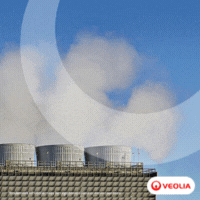Siemens Modernizes Coke-Oven By-Product Plant for Isdemir
05/09/2008 - Siemens Metals Technologies completes the expansion and modernization of a coke-oven by-product plant for Turkish steel producer Isdemir.
|
As part of a campaign to expand annual steel production to approximately 6.25 million tonnes by the end of 2009, the Turkish steel producer Isdemir, located in Iskenderun on the Mediterranean coast, is modernizing and expanding its production facilities.
To meet the increased coke demands for a new blast furnace that is currently under construction, two additional coke-oven batteries (No. 5 and No. 6) were built to increase the coke production from 1.2 to 2.4 million tons per year.
The coke-plant expansion necessitated an expansion and modernization of the existing coke-oven by-product plant to treat the increased quantities of generated coke-oven gas.
With the by-product plant upgrade, Isdemir can now extract and sell approximately 40,000 tonnes/year of ammonium sulfate, 75,000 tonnes/year of tar and 30,000 tonnes/year of benzol.
|
The by-product plant upgrade featured the addition of two semi-separate gas-treatment lines, which have helped to increase the facility’s processing capacity from 70,000 to 140,000 Nm3 of coke-oven gas per hour. With the expansion, Isdemir can now extract and sell approximately 40,000 tonnes/year of ammonium sulfate, 75,000 tonnes/year of tar and 30,000 tonnes/year of benzol.
The upgrade has also helped the facility to significantly reduce its environmental emissions, thanks to the process automation supplied by Siemens, which enables plant monitoring and operating functions to be carried out from a central control pulpit. Precise monitoring and process control ensures that the plant achieves highest efficiency at a high level of quality control and operational safety.
Siemens’ project scope included the engineering and supply of mechanical equipment, instrumentation, electrics and automation as well as the supervision of construction and commissioning. A central part of the project is the new automation and process control technology.
Level 1 automation comprises the fully redundant Simatic PCS7 DCS system to ensure that the plant has near-zero downtime. Level 2 automation is equipped with a historian analysis system to support process performance investigations and also SPC (statistical process control) analyses, providing the operator with a basis for continuous optimization of the process.
All plant and process data are now readily available in a central control room, facilitating plant operations and monitoring. Precise knowledge of all the relevant information supports the personnel at achieving highest efficiency with respect to the removal of ammonia, BTX (benzene, toluene and xylene) or tar from the coke-oven gas. The operation software was designed and developed to enable early detection of process or equipment problems.
Siemens also carried out extensive mechanical equipment upgrades and installations. This included sand-blasting and retubing of the primary gas-cooling system’s ten existing primary coolers as well as the installation of two new primary coolers. The cooling towers for primary gas cooling were also refurbished, with two new cells added along with filtration and chemical-dosing systems. Eight tar precipitators were completely rebuilt, using only the shells of the existing units. The entire gas-exhaust system was overhauled to cope with the increased gas quantities.
The facility’s ammonium sulfate production and drying section was completely demolished and reconstructed as two production lines comprising three new ammonia absorbers and two independent crystallizing lines. Three serial crude-benzene scrubbers in each of the two independent production lines were upgraded to increase their capacity, and the crude benzene recovery line was completely rebuilt.
Two new high-efficiency flushing-liquor and tar decanters were installed to handle higher outputs. The ammonia liquor distillation section was reconstructed to enhance the settling and stripping of ammonia to boost ammonium sulfate production as well as to satisfy strict environmental regulations. The existing cooling towers for final cooling were demolished and rebuilt with filtration and chemical-dosing systems. A completely new foul-water system was also supplied and the biological effluent-treatment line was completely overhauled to comply with stricter environmental regulations.


.png?mediaprotectionhash=3750102d6e35cf158ae995d2a880e68af6bba8e3c74cb3bcacc2f4a4a71af45a&width=220&height=200&ext=.png)
-(1)-Reinhausen-(1).jpg?lang=en-US&ext=.jpg)




-Cutsforth.png?width=100&height=200&mediaprotectionhash=4482cb5f76125ba3348ab8851ab91d4ab118b35e517c017615489ff39c41f1af&ext=.png)